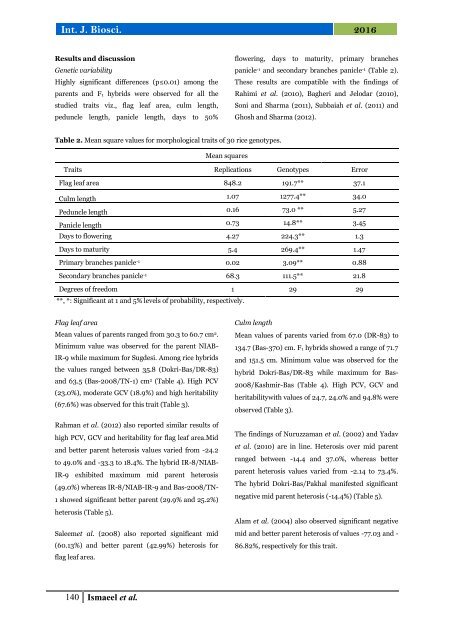Genetic variability and heterosis among rice genotypes for yield and yield associated traits
The present research was performed to assess genetic variability and heterosis among 30 rice genotypes for yield and yield associated traits. Sixteen F1 hybrids and their 14 parents were planted in a randomized complete block design using two replications at The University of Agriculture Peshawar, during 2011 rice crop growing season. Highly significant differences among the parents and F1 hybrids were observed for all the traits studied. The parental genotypes Bas-370, Pakhal and IR-8 displayed maximum values for panicle length (32.5 cm), primary branches panicle-1 (15.1)and secondary branches panicle-1 (47.0), respectively. Among the F1 cross combinations, IR-8/Sugdesi manifested higher mean values for primary branches panicle-1 (15.0) and secondary branches panicle-1 (55.0) whereas Bas-6129/Bas-370 showed maximum value for panicle length (34.0cm). Moderate and low phenotypic coefficient of variation (PCV) and genotypic coefficient of variation (GCV) were observed for most of the traits. High broad sense heritability values were observed for all the studied traits except primary branches panicle-1.Bas-2008/Kashmir-Bas showed the highest positive values of mid and better parent heterosis for primary branches panicle-1 (33.3 and 19.0%) while Bas-2008/Kashmir-Bas and Dokri-Bas/Bas-6129 for secondary branches panicle-1(44.2% and 30.6%), respectively. On the basis of superior performance for yield and yield associated traits, the parental genotypes IR-8 and Pakhal whereas the F1 hybrids IR-8/Sugdesi and Bas- 2008/Kashmir-Bas are recommended for onward use in rice hybridization programs.
The present research was performed to assess genetic variability and heterosis among 30 rice genotypes for yield and yield associated traits. Sixteen F1 hybrids and their 14 parents were planted in a randomized complete block design using two replications at The University of Agriculture Peshawar, during 2011 rice crop growing season. Highly significant differences among the parents and F1 hybrids were observed for all the traits studied. The
parental genotypes Bas-370, Pakhal and IR-8 displayed maximum values for panicle length (32.5 cm), primary branches panicle-1 (15.1)and secondary branches panicle-1 (47.0), respectively. Among the F1 cross combinations,
IR-8/Sugdesi manifested higher mean values for primary branches panicle-1 (15.0) and secondary branches panicle-1 (55.0) whereas Bas-6129/Bas-370 showed maximum value for panicle length (34.0cm). Moderate and low phenotypic coefficient of variation (PCV) and genotypic coefficient of variation (GCV) were observed for most of the traits. High broad sense heritability values were observed for all the studied traits except primary branches panicle-1.Bas-2008/Kashmir-Bas showed the highest positive values of mid and better parent heterosis for primary branches panicle-1 (33.3 and 19.0%) while Bas-2008/Kashmir-Bas and Dokri-Bas/Bas-6129 for secondary branches panicle-1(44.2% and 30.6%), respectively. On the basis of superior performance for yield and yield associated traits, the parental genotypes IR-8 and Pakhal whereas the F1 hybrids IR-8/Sugdesi and Bas- 2008/Kashmir-Bas are recommended for onward use in rice hybridization programs.
You also want an ePaper? Increase the reach of your titles
YUMPU automatically turns print PDFs into web optimized ePapers that Google loves.
Int. J. Biosci. 2016<br />
Results <strong>and</strong> discussion<br />
<strong>Genetic</strong> <strong>variability</strong><br />
Highly significant differences (p≤0.01) <strong>among</strong> the<br />
parents <strong>and</strong> F1 hybrids were observed <strong>for</strong> all the<br />
studied <strong>traits</strong> viz., flag leaf area, culm length,<br />
peduncle length, panicle length, days to 50%<br />
flowering, days to maturity, primary branches<br />
panicle -1 <strong>and</strong> secondary branches panicle -1 (Table 2).<br />
These results are compatible with the findings of<br />
Rahimi et al. (2010), Bagheri <strong>and</strong> Jelodar (2010),<br />
Soni <strong>and</strong> Sharma (2011), Subbaiah et al. (2011) <strong>and</strong><br />
Ghosh <strong>and</strong> Sharma (2012).<br />
Table 2. Mean square values <strong>for</strong> morphological <strong>traits</strong> of 30 <strong>rice</strong> <strong>genotypes</strong>.<br />
Mean squares<br />
Traits Replications Genotypes Error<br />
Flag leaf area 848.2 191.7** 37.1<br />
Culm length 1.07 1277.4** 34.0<br />
Peduncle length 0.16 73.0 ** 5.27<br />
Panicle length 0.73 14.8** 3.45<br />
Days to flowering 4.27 224.3** 1.3<br />
Days to maturity 5.4 269.4** 1.47<br />
Primary branches panicle -1 0.02 3.09** 0.88<br />
Secondary branches panicle -1 68.3 111.5** 21.8<br />
Degrees of freedom 1 29 29<br />
**, *: Significant at 1 <strong>and</strong> 5% levels of probability, respectively.<br />
Flag leaf area<br />
Mean values of parents ranged from 30.3 to 60.7 cm 2 .<br />
Minimum value was observed <strong>for</strong> the parent NIAB-<br />
IR-9 while maximum <strong>for</strong> Sugdesi. Among <strong>rice</strong> hybrids<br />
the values ranged between 35.8 (Dokri-Bas/DR-83)<br />
<strong>and</strong> 63.5 (Bas-2008/TN-1) cm 2 (Table 4). High PCV<br />
(23.0%), moderate GCV (18.9%) <strong>and</strong> high heritability<br />
(67.6%) was observed <strong>for</strong> this trait (Table 3).<br />
Rahman et al. (2012) also reported similar results of<br />
high PCV, GCV <strong>and</strong> heritability <strong>for</strong> flag leaf area.Mid<br />
<strong>and</strong> better parent <strong>heterosis</strong> values varied from -24.2<br />
to 49.0% <strong>and</strong> -33.3 to 18.4%. The hybrid IR-8/NIAB-<br />
IR-9 exhibited maximum mid parent <strong>heterosis</strong><br />
(49.0%) whereas IR-8/NIAB-IR-9 <strong>and</strong> Bas-2008/TN-<br />
1 showed significant better parent (29.9% <strong>and</strong> 25.2%)<br />
<strong>heterosis</strong> (Table 5).<br />
Saleemet al. (2008) also reported significant mid<br />
(60.13%) <strong>and</strong> better parent (42.99%) <strong>heterosis</strong> <strong>for</strong><br />
flag leaf area.<br />
Culm length<br />
Mean values of parents varied from 67.0 (DR-83) to<br />
134.7 (Bas-370) cm. F1 hybrids showed a range of 71.7<br />
<strong>and</strong> 151.5 cm. Minimum value was observed <strong>for</strong> the<br />
hybrid Dokri-Bas/DR-83 while maximum <strong>for</strong> Bas-<br />
2008/Kashmir-Bas (Table 4). High PCV, GCV <strong>and</strong><br />
heritabilitywith values of 24.7, 24.0% <strong>and</strong> 94.8% were<br />
observed (Table 3).<br />
The findings of Nuruzzaman et al. (2002) <strong>and</strong> Yadav<br />
et al. (2010) are in line. Heterosis over mid parent<br />
ranged between -14.4 <strong>and</strong> 37.0%, whereas better<br />
parent <strong>heterosis</strong> values varied from -2.14 to 73.4%.<br />
The hybrid Dokri-Bas/Pakhal manifested significant<br />
negative mid parent <strong>heterosis</strong> (-14.4%) (Table 5).<br />
Alam et al. (2004) also observed significant negative<br />
mid <strong>and</strong> better parent <strong>heterosis</strong> of values -77.03 <strong>and</strong> -<br />
86.82%, respectively <strong>for</strong> this trait.<br />
140 Ismaeel et al.


















